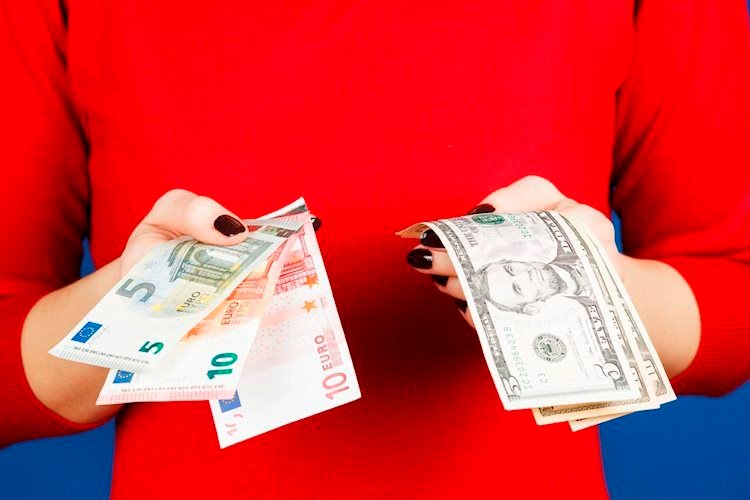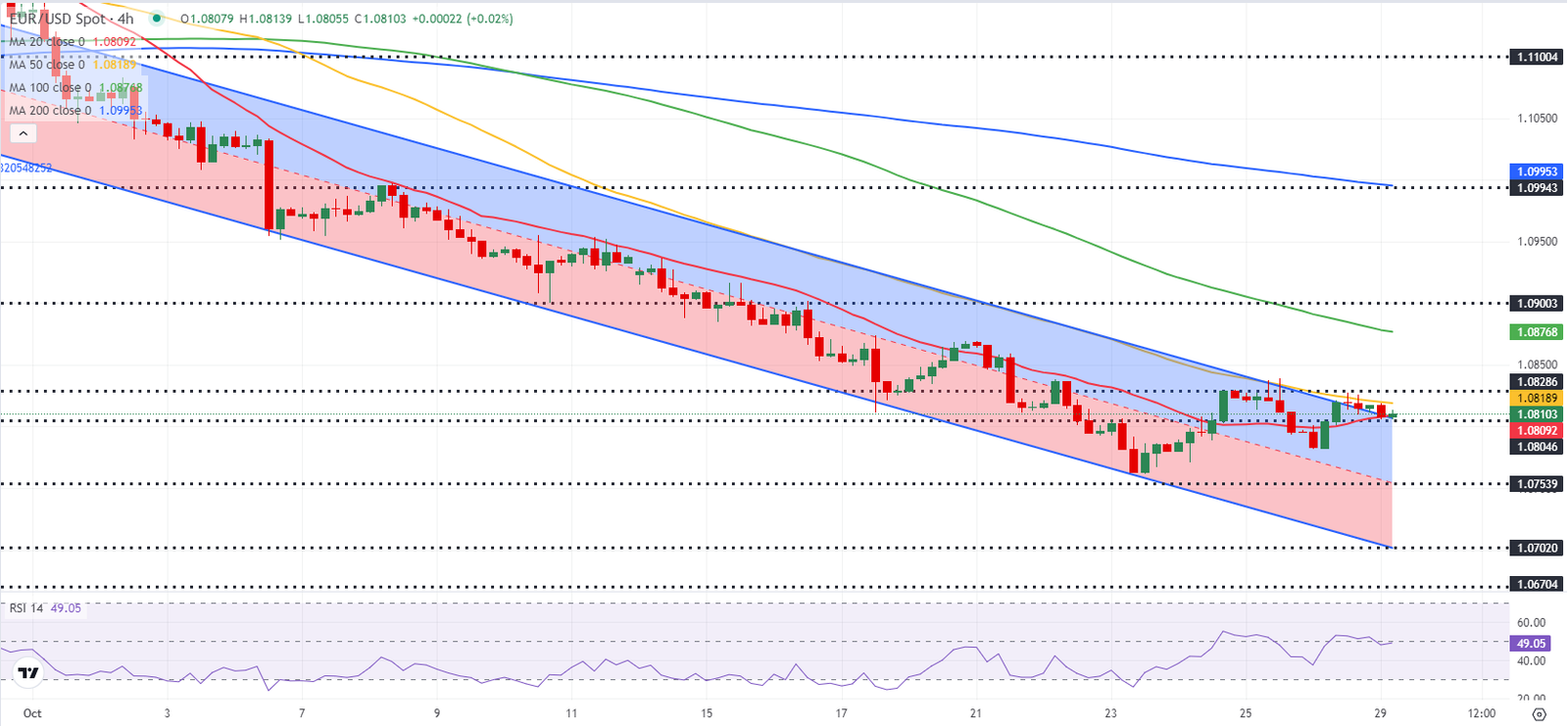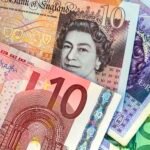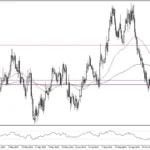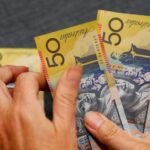- EUR/USD trades in a tight range above 1.0800 early Tuesday.
- The near-term technical outlook is yet to point to a buildup of bullish momentum.
- US economic calendar will feature Consumer Confidence and JOLTS Job Openings data.
EUR/USD moves sideways slightly above 1.0800 early Tuesday after managing to post small daily gains on Monday. The pair’s technical outlook highlights a neutral stance in the near term.
Euro PRICE Last 7 days
The table below shows the percentage change of Euro (EUR) against listed major currencies last 7 days. Euro was the weakest against the Swiss Franc.
| USD | EUR | GBP | JPY | CAD | AUD | NZD | CHF | |
|---|---|---|---|---|---|---|---|---|
| USD | 0.05% | 0.11% | 1.55% | 0.42% | 1.39% | 0.91% | -0.02% | |
| EUR | -0.05% | 0.06% | 1.51% | 0.36% | 1.32% | 0.87% | -0.07% | |
| GBP | -0.11% | -0.06% | 1.43% | 0.31% | 1.27% | 0.79% | -0.13% | |
| JPY | -1.55% | -1.51% | -1.43% | -1.12% | -0.16% | -0.65% | -1.54% | |
| CAD | -0.42% | -0.36% | -0.31% | 1.12% | 0.98% | 0.49% | -0.44% | |
| AUD | -1.39% | -1.32% | -1.27% | 0.16% | -0.98% | -0.48% | -1.40% | |
| NZD | -0.91% | -0.87% | -0.79% | 0.65% | -0.49% | 0.48% | -0.92% | |
| CHF | 0.02% | 0.07% | 0.13% | 1.54% | 0.44% | 1.40% | 0.92% |
The heat map shows percentage changes of major currencies against each other. The base currency is picked from the left column, while the quote currency is picked from the top row. For example, if you pick the Euro from the left column and move along the horizontal line to the US Dollar, the percentage change displayed in the box will represent EUR (base)/USD (quote).
The US Dollar (USD) started the week on a bullish note but failed to preserve its strength in the second half of the day as investors refrained from taking large positions in the absence of fundamental drivers.
Meanwhile, European Central Bank (ECB) Vice President Luis de Guindos said late Monday that the central bank has made significant progress in bringing down inflation but added that they can’t declare victory just yet. Speaking again early Tuesday, de Guindos noted that they will keep all options open at forthcoming policy meetings.
The US Bureau of Labor Statistics will publish JOLTS Job Openings data for September later in the day. Markets expect the number of job openings to stand at 7.99 million, down slightly from 8.04 million announced in August. A significant upside surprise, with a reading of 8.5 million or higher, could boost the USD with the immediate reaction and weigh on the pair. On the other hand, a print of 7.5 million or lower could have the opposite impact on the USD’s valuation.
The US economic calendar will also feature the Conference Board’s Consumer Confidence Index data for October. Ahead of the Gross Domestic Product (GDP) and Nonfarm Payrolls (NFP) releases later in the week, the market reaction to Tuesday’s data could remain short-lived.
EUR/USD Technical Analysis
EUR/USD was last seen trading slightly above the upper limit of the descending regression channel coming from late September. Meanwhile, the Relative Strength Index (RSI) indicator on the 4-hour chart moves sideways at around 50, reflecting the pair’s indecisiveness.
On the upside, 1.0830 (static level) aligns as interim resistance before 1.0870 (200-day Simple Moving Average) and 1.0900 (round level). In case the pair retreats below 1.0800 (round level) and starts using this level as resistance, 1.0750 (mid-point of the descending channel) and 1.0700 (lower limit of the descending channel) could be seen as next support levels.
Euro FAQs
The Euro is the currency for the 19 European Union countries that belong to the Eurozone. It is the second most heavily traded currency in the world behind the US Dollar. In 2022, it accounted for 31% of all foreign exchange transactions, with an average daily turnover of over $2.2 trillion a day. EUR/USD is the most heavily traded currency pair in the world, accounting for an estimated 30% off all transactions, followed by EUR/JPY (4%), EUR/GBP (3%) and EUR/AUD (2%).
The European Central Bank (ECB) in Frankfurt, Germany, is the reserve bank for the Eurozone. The ECB sets interest rates and manages monetary policy. The ECB’s primary mandate is to maintain price stability, which means either controlling inflation or stimulating growth. Its primary tool is the raising or lowering of interest rates. Relatively high interest rates – or the expectation of higher rates – will usually benefit the Euro and vice versa. The ECB Governing Council makes monetary policy decisions at meetings held eight times a year. Decisions are made by heads of the Eurozone national banks and six permanent members, including the President of the ECB, Christine Lagarde.
Eurozone inflation data, measured by the Harmonized Index of Consumer Prices (HICP), is an important econometric for the Euro. If inflation rises more than expected, especially if above the ECB’s 2% target, it obliges the ECB to raise interest rates to bring it back under control. Relatively high interest rates compared to its counterparts will usually benefit the Euro, as it makes the region more attractive as a place for global investors to park their money.
Data releases gauge the health of the economy and can impact on the Euro. Indicators such as GDP, Manufacturing and Services PMIs, employment, and consumer sentiment surveys can all influence the direction of the single currency. A strong economy is good for the Euro. Not only does it attract more foreign investment but it may encourage the ECB to put up interest rates, which will directly strengthen the Euro. Otherwise, if economic data is weak, the Euro is likely to fall. Economic data for the four largest economies in the euro area (Germany, France, Italy and Spain) are especially significant, as they account for 75% of the Eurozone’s economy.
Another significant data release for the Euro is the Trade Balance. This indicator measures the difference between what a country earns from its exports and what it spends on imports over a given period. If a country produces highly sought after exports then its currency will gain in value purely from the extra demand created from foreign buyers seeking to purchase these goods. Therefore, a positive net Trade Balance strengthens a currency and vice versa for a negative balance.

